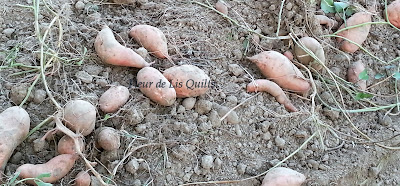Yesterday afternoon I went out to the farm with Richard and snapped a few photos of the sweet potato rows that he'd opened. He and a few other men went out early this morning, as they have every morning for the last week or so, to pick the potatoes off the ground.
We love sweet potatoes and yams and, though they are not the same, people do often use the terms interchangeably. Sweet potatoes are delicious, can be cooked in a variety of ways, and are nutritious. (See nutritional info at the end of this post.)
Picking potatoes is hot, heavy, dirty work. (Yes, I've helped, but that was long ago.) The men carry crates out and pick through each cluster of potatoes choosing the better ones first and leaving the second grade potatoes behind. Once the potatoes are all in wooden crates, they are taken to the storage shed and stacked up until they're sold. They are left unwashed to cure in storage. When ready for sale, we take them out to wash and regrade, then put them in cardboard boxes. The wooden crates are stored in the shed to reuse.
How to bake:
When you get your potatoes, wash them well and remove any blemishes or stems with a small peeler. Leave the skin on and slather on the butter. Butter, margarine, or your favorite oil (you choose but be generous) will help keep the juices inside the root, add flavor, and help to release the peelings when the baking is done. Place the veggies in a shallow pan lined with foil and bake at 350 degrees for about an hour or so. The baking time will vary depending on the size of the potato and how well it's been cured. Potatoes that are small in diameter will bake much faster than those that are big. I generally begin checking them after an hour. A gentle squeeze will tell you how soft they are but you can also prick one with a fork. When they're really soft and squishy, remove them. If necessary let the bigger ones bake a little longer.
When I cook a big pan of potatoes, I take out the smallest ones and spread out the others so the heat can around them better. I also use my convection oven since it speeds up the baking, but I've baked lots in the regular oven, and either one works well.
Need sweet potatoes? Email me, I think we can hook you up!
For more information, click on the links below:
1 medium sweet potato counts as 1 cup in the
MyPyramid.gov Vegetable Group. For a 2,000-
calorie diet, the daily recommendation
is about 2 ½ cups of vegetables.
1 medium sweet potato provides more than a
day’s worth of vitamin A and 35% of the daily
recommended amount of vitamin C.
Fats 0g
Cholestrol 0g
Sodium 73mg
Total Carbohydrates 27g
Fiber 4g
Sugar 6g
Protein 2g






1 comment:
Thanks for the nutritional information about sweet potatoes. I didn't know they are so healthy.
Post a Comment